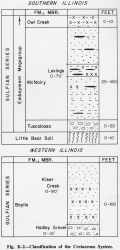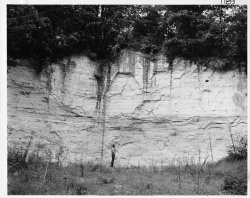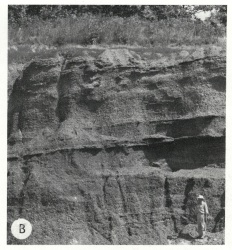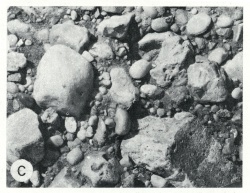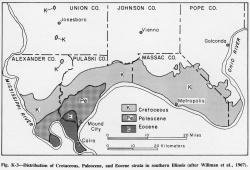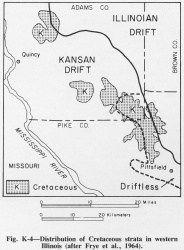Cretaceous System
Lithostratigraphy: Embayment Megagroup
Chronostratigraphy: Mesozoic Erathem >>Cretaceous System
Primary source
Willman, H. B., Elwood Atherton, T. C. Buschbach, Charles Collinson, John C. Frye, M. E. Hopkins, Jerry A. Lineback, and Jack A. Simon, 1975, Handbook of Illinois Stratigraphy: Illinois State Geological Survey Bulletin 95, 261 p.
Contributing author(s)
H. B. Willman and John C. Frye
Name
Original description
The Cretaceous System (D'Halloy, 1822).
Derivation
Named for the chalk formations of France.
Other names
History/background
Type section
Type location
Type author(s)
Type status
Reference section
Reference location
Reference author(s)
Reference status
Stratigraphic relationships
Extent and thickness
It is restricted in Illinois to five counties in extreme southern Illinois and to areas in Pike and Adams Counties in western Illinois.
Lithology
The southern Illinois Cretaceous rocks are largely nonmarine sand containing beds of lignitic silt and clay, lignite, and gravel. The major part of the Cretaceous in this area is assigned to the McNairy Formation, but the patches of gravel at the base are assigned to the Tuscaloosa Formation, and a thin, marine sandy silt at the top is assigned to the Owl Creek Formation (fig. K-2). The heavy minerals of the sands are characterized by a high content of kyanite and by appreciable amounts of staurolite, tourmaline, sillimanite, zircon, and rutile. The clay minerals in the nonmarine sediments are largely kaolinite, whereas those in the marine sediments are dominantly montmorillonite (Pryor and Glass, 1961). The mineralogy indicates the sediments were derived from the metamorphic rocks of the Piedmont region to the east or southeast. The sediments were carried into the Embayment region by a river on the sub-cretaceous erosional surface.
Cretaceous rocks in western Illinois, all assigned to the Baylis Formation, are largely sand and clayey sand that are generally nearly white, although they are rusty brown where weathered. They commonly contain a bed of gravel at the base and, in some localities, beds of gray to dark gray silty clay. The heavy minerals in the sands are dominantly zircon, tourmaline, and staurolite, in percentages close to those in the Cretaceous deposits of Iowa and Kansas. The dominant clay mineral varies from bed to bed, from montmorillonite to illite to kaolinite, indicating the mixed compositions of nearshore environments and derivation largely from northern sources. Similar compsitions were found in samples of the Cretaceous in Iowa. The mineral composition and sediment characteristics distinguish these deposits from glacial deposits.
Core(s)
Photograph(s)
Contacts
Well log characteristics
Fossils
Age and correlation
The Cretaceous age of the southern Illinois deposits is indicated by the presence of a few distinctive Foraminifera in the Owl Creek Formation, by abundant plant fossils in the lignitic beds, and by the equivalence of the deposits to the abundantly fossiliferous marine sediments south of Illinois. No fossils have been found in the western Illinois deposits, but the composition of the gravels, the heavy minerals in the sands, and the clay mineral assemblages are all similar to those of the Cretaceous rocks in Iowa. From their stratigraphic position, the sediments could be Tertiary in age, but they appear to have been deeply eroded before the near-by late Tertiary gravel was deposited.
Environments of deposition
The Cretaceous rocks in southern Illinois (Glenn, 1906; Lamar and Sutton, 1930; Stearns, 1958; Pryor, 1960; Pryor and Ross, 1962; Ross, 1963, 1964) (figs. K-1, K-2) are at the north end of the Mississippi Embayment of the Gulf Coastal Plain (fig. K-3). They are entirely clastic rocks- the nonmarine part of a large delta built where a river from the east discharged into the head of the embayment. A thin marine deposit occurs at the top. The Cretaceous rocks are as much as 500 feet thick near Cairo, where they are overlain by Paleocene sediments, but they thin rapidly northward as they are truncated by younger Tertiary and Pleistocene sediments.
|
The Cretaceous rocks in western Illinois (Frye et al., 1964) (fig. K-4) also are clastic rocks, largely sand, and as much as 100 feet thick. They are the easternmost outliers of Cretaceous sediments that formerly covered the region east of the Rocky Mountains and north of the Ozarks. The outliers in Illinois are nearly 200 miles from the nearest Cretaceous exposures in west-central Iowa. They appear to be beach and nearshore sediments deposited in the advancing Cretaceous sea.
Although the deposits are dominantly quartz sand in both areas, they differ noticeably in other mineral constituents. The two regions were separated by a barrier, probably a low eastern extension of the Ozark Uplift across southern Illinois.
The Cretaceous sediments in southern Illinois terminate northward as they are truncated by Tertiary deposits. The presence of Cretaceous-type gravel and white clays in possible sink holes as far north as Kaolin, northwest of Anna, Union County, suggests that Cretaceous deposits formerly were more extensive than they are now, although they probably did not extend significantly north of their present area. Cretaceous rocks in western Illinois terminate southward against an area of higher Mississippian formations, indicating that Cretaceous sediments may never have been deposited in the area between there and extreme southern Illinois.
The Cretaceous rocks in western Illinois appear to have been deposited on a nearly flat surface eroded across various Mississippian and Pennsylvanian formations. In southern Illinois, variations in thickness of the Cretaceous sediments have commonly been interpreted as indicating significant relief on the pre-Cretaceous surface because the outcropping Cretaceous rocks show none of the intensive faulting found in the Paleozoic rocks immediately north of the Cretaceous area. However, Ross (1963) questioned this interpretation because subsurface information showed that the basal thin gravel and the Little Bear Soil beneath it are more widespread than originally thought and that the thickness variations of the Cretaceous parallel the structures in the Paleozoic rocks. Consequently, he related the irregularities of the sub-Cretaceous surface to Cretaceous and possible post-Cretaceous movements of some of the major faults.
Economic importance
Remarks
References
D'HALLOY, J. J. D'OMALIUS, 1822, Observations sur un essai de carte géologique de la France, des Pays-Bas et des contrees voisines: Annales des Mines, v. 7, p. 373-374.
FRYE, J. C., H. B. WILLMAN and H. D. GLASS, 1964, Cretaceous deposits and the Illinoian glacial boundary in western Illinois: Illinois State Geological Survey Circular 364, 28 p.
GLENN, L. C., 1906, Underground waters of Tennessee and Kentucky west of Tennessee River and of an adjacent area in Illinois: USGS Water Supply and Irrigation Paper 164, 173 p.
LAMAR, J. E., and A. H. SUTTON, 1930, Cretaceous and Tertiary sediments of Kentucky, Illinois, and Missouri: American Association of Petroleum Geologists Bulletin, v. 14, p. 845-866.
PRYOR, W. A., 1960, Cretaceous sedimentation in upper Mississippi Embayment: American Association of Petroleum Geologists Bulletin, v. 44, p. 1473-1504; Illinois State Geological Survey Reprint 1960-J.
PRYOR, W. A., and H. D. GLASS, 1961, Cretaceous-Tertiary clay mineralogy of the upper Mississippi Embayment: Journal of Sedimentary Petrology, v. 31, p. 36-51; Illinois State Geological Survey Reprint 1961-M.
PRYOR, W. A., and C. A. ROSS, 1962, Geology of the Illinois parts of the Cairo, La Center, and Thebes Quadrangles: Illinois State Geological Survey Circular 332, 39 p.
ROSS, C. A., 1963, Structural framework of southernmost Illinois: Illinois State Geological Survey Circular 351, 27
ROSS, C. A., 1964, Geology of the Paducah and Smithland Quadrangles in Illinois: Illinois State Geological Survey Circular 360, 32 p.
STEARNS, R. G., 1958, Cretaceous, Paleocene, and Lower Eocene geologic history of the northern Mississippi Embayment: Geological Society of America Bulletin. v. 68, p. 1077-1100.
ISGS Codes
| Stratigraphic Code | Geo Unit Designation |
|---|---|
